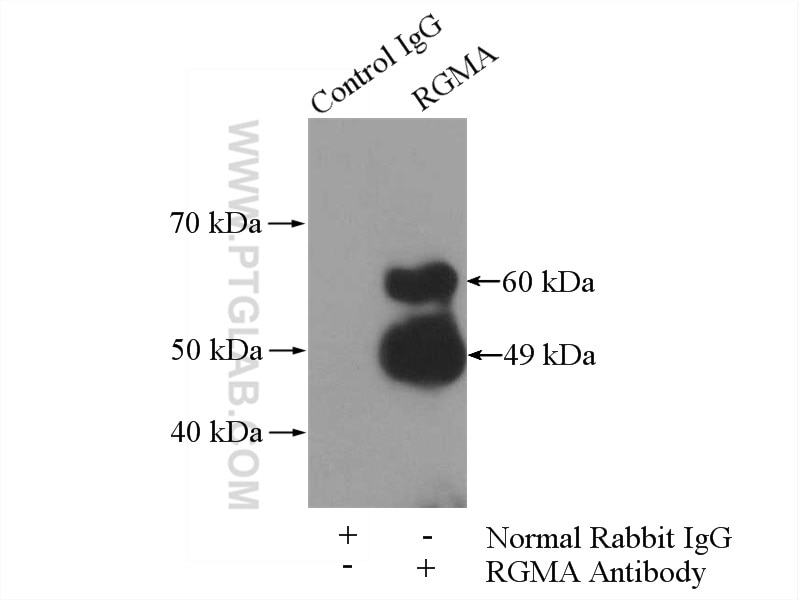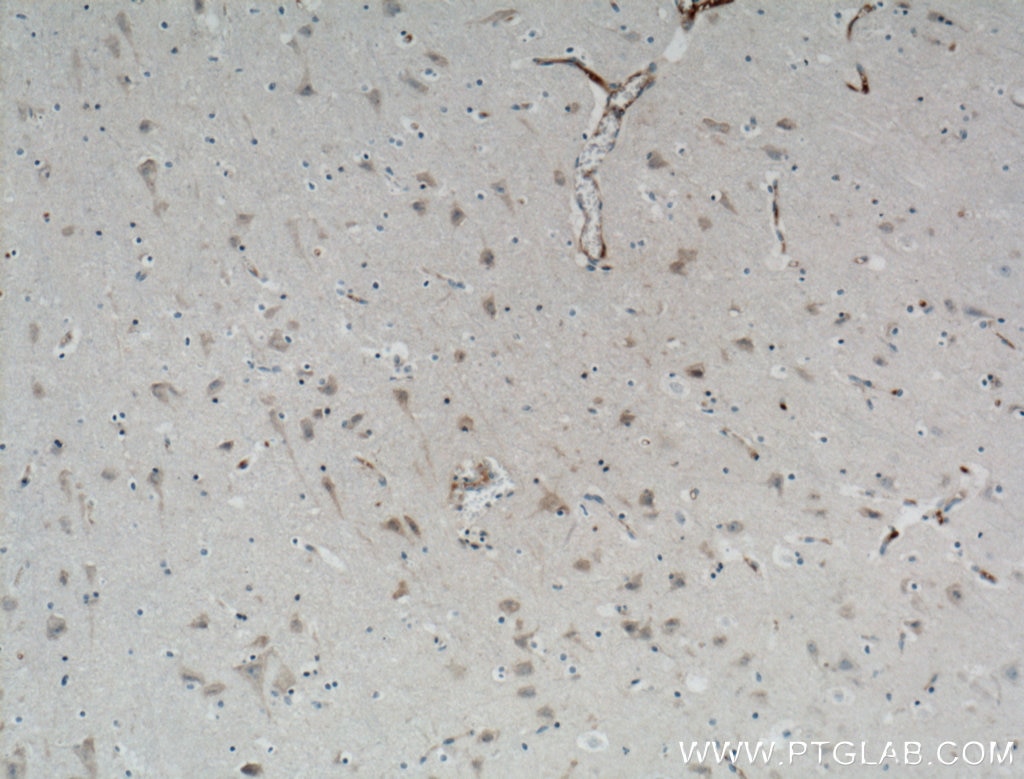Tested Applications
| Positive WB detected in | COLO 320 cells, mouse testis tissue, HeLa cells, MOLT-4 cells, U2OS cells, Caco-2 cells, K-562 cells, mouse brain tissue, rat brain tissue |
| Positive IP detected in | mouse testis tissue |
| Positive IHC detected in | human brain tissue Note: suggested antigen retrieval with TE buffer pH 9.0; (*) Alternatively, antigen retrieval may be performed with citrate buffer pH 6.0 |
Recommended dilution
| Application | Dilution |
|---|---|
| Western Blot (WB) | WB : 1:500-1:1000 |
| Immunoprecipitation (IP) | IP : 0.5-4.0 ug for 1.0-3.0 mg of total protein lysate |
| Immunohistochemistry (IHC) | IHC : 1:50-1:500 |
| It is recommended that this reagent should be titrated in each testing system to obtain optimal results. | |
| Sample-dependent, Check data in validation data gallery. | |
Published Applications
| KD/KO | See 1 publications below |
| WB | See 2 publications below |
| CoIP | See 1 publications below |
Product Information
12387-1-AP targets RGMA in WB, IHC, IP, CoIP, ELISA applications and shows reactivity with human, mouse, rat samples.
| Tested Reactivity | human, mouse, rat |
| Cited Reactivity | human, mouse, rat |
| Host / Isotype | Rabbit / IgG |
| Class | Polyclonal |
| Type | Antibody |
| Immunogen |
CatNo: Ag3058 Product name: Recombinant human RGMA protein Source: e coli.-derived, PGEX-4T Tag: GST Domain: 136-485 aa of BC015886 Sequence: SAVHGIEDLMSQHNCSKDGPTSQPRLRTLPPAGDSQERSDSPEICHYEKSFHKHSATPNYTHCGLFGDPHLRTFTDRFQTCKVQGAWPLIDNNYLNVQVTNTPVLPGSAATATSKLTIIFKNFQECVDQKVYQAEMDELPAAFVDGSKNGGDKHGANSLKITEKVSGQHVEIQAKYIGTTIVVRQVGRYLTFAVRMPEEVVNAVEDWDSQGLYLCLRGCPLNQQIDFQAFHTNAEGTGARRLAAASPAPTAPETFPYETAVAKCKEKLPVEDLYYQACVFDLLTTGDVNFTLAAYYALEDVKMLHSNKDKLHLYERTRDLPGRAAAGLPLAPRPLLGALVPLLALLPVFC Predict reactive species |
| Full Name | RGM domain family, member A |
| Calculated Molecular Weight | 450 aa, 49 kDa |
| Observed Molecular Weight | 49 kDa |
| GenBank Accession Number | BC015886 |
| Gene Symbol | RGMA |
| Gene ID (NCBI) | 56963 |
| RRID | AB_2179366 |
| Conjugate | Unconjugated |
| Form | Liquid |
| Purification Method | Antigen affinity purification |
| UNIPROT ID | Q96B86 |
| Storage Buffer | PBS with 0.02% sodium azide and 50% glycerol, pH 7.3. |
| Storage Conditions | Store at -20°C. Stable for one year after shipment. Aliquoting is unnecessary for -20oC storage. 20ul sizes contain 0.1% BSA. |
Background Information
RGMA, also named as RGM, is a member of the repulsive guidance molecule (RGM) family that performs several functions in the developing and adult nervous system. It regulates cephalic neural tube closure, inhibits neurite outgrowth and cortical neuron branching, and the formation of mature synapses. RGMA binding to its receptor NEO1/neogenin induces activation of RHOA-ROCK1/Rho-kinase signaling pathway through UNC5B-ARHGEF12/LARG-PTK2 cascade, leading to collapse of the neuronal growth cone and neurite outgrowth inhibition. Furthermore, RGMA binding to NEO1/neogenin leads to HRAS inactivation by influencing HRAS1-PTK2-AKT1 pathway. It also functions as a bone morphogenetic protein (BMP) coreceptor that may signal through SMAD1, SMAD5, and SMAD8. RGMA is a molecular target for neuroprotection in retinal pathologies(PMID: 20457227). the frequent genetic and epigenetic inactivation of RGMA in CRCs and adenomas along with its in vitro function collectively support its role as a tumor suppressor in colon cells(PMID:19303019 ). There're some different MW in WB detection, 30 kDa mature form, 47-50 kDa isoforms and 60 kDa Glycosylated form.
Protocols
| Product Specific Protocols | |
|---|---|
| IHC protocol for RGMA antibody 12387-1-AP | Download protocol |
| IP protocol for RGMA antibody 12387-1-AP | Download protocol |
| WB protocol for RGMA antibody 12387-1-AP | Download protocol |
| Standard Protocols | |
|---|---|
| Click here to view our Standard Protocols |
Publications
| Species | Application | Title |
|---|---|---|
Brain Res Bull Adenoviral Vector-Induced Silencing of RGMa Attenuates Blood-Brain Barrier Dysfunction in a Rat Model of MCAO/Reperfusion.
| ||
Funct Integr Genomics Integration of scRNA-seq and bulk tissue RNA-seq data to identify cancer-associated fibroblast-related gene RGMA as a potential treatment target for esophageal cancer | ||
Sci Adv RGMa collapses the neuronal actin barrier against disease-implicated protein and exacerbates ALS |














